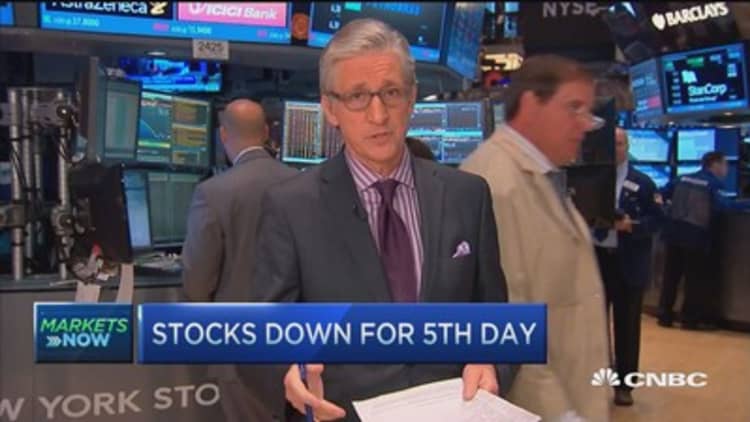
The Shanghai Composite closed down 8.5 percent Monday, the biggest single-day loss in eight years, while the Shenzhen was down 7 percent.
On the Shanghai, there were 75 stocks declining for every one advancing. Ouch.
It's not clear what caused the decline. There are the usual rumors that the government would either not continue to support the market or that such support would be ineffective.
What is clear is it's becoming impossible to make an investment decision on China right now. It's a complete wild card. Chinese stocks could be down another 8 percent tomorrow, or up 8 percent. There's no way to know.
Read More What's fueling the frenzy in China stocks?
China's weakness is spilling over into the rest of Asia:
- Hong Kong: down 3.1 percent
- Taiwan: down 2.4 percent
- Thailand: down 1.8 percent
- Indonesia: down 1.8 percent
- Phillipines: down 1.5 percent
And it's spilling over into the commodity markets. Copper is down 1 percent to its lowest level in 6 years. Crude is weak, with West Texas Intermediate down 1.6 percent to $47.38. We are getting very close to the March 17 closing low of $43.46, which was the lowest close since 2009.
Not surprisingly, the commodity names are weak again, with energy names like EOG Resources and metals equities like Freeport McMoran all down at the open.
So much for the idea that China doesn't matter much for the U.S. investor. It does, because it impacts commodity prices, as well as materials, industrials, and energy stocks.
This is creating some very strange statistics. For example, the S&P materials sectors is almost 2.8 standard deviations (SD) below its 50-day moving average, the energy sector is 2.42 SD below, and the industrials are 2.38 SD below, according to our partners at Kensho.
This is very rare territory. Standard deviation of 3, for example, means the sample is within all observable samples 99.7 percent of the time. These are not yet 3 SDs, but they're close. We are in 98 percent territory, surely. In other words, these sectors are very stretched on the downside. A typical quant would look at this as a potential buy signal.
Read More Why US stocks may rebound in second half: Strategists
Indeed, Kensho noted that this has only happened 29 times since 1989 for materials, and that 24 of the 29 times the next move was up.
This indeed would normally be a strong buy signal for these beat-up sectors. But with China growth in doubt, it's creating big problems. Just because you drift back into more normal territory doesn't mean you will necessarily get a significant bounce.
Europe is weak as well, with Germany's DAX facing its fifth day of losses, down 1.8 percent at midday in Europe. Talks between Greece and its creditors over a bailout were scheduled to begin tomorrow but have been delayed for at least two days due to "organizational issues."
The Greek stock exchange remains closed.
In the United States, the June durable goods report was better than expected, but downward revisions in May muted the impact. It's important to note that core capital expenditures, which is what most look at when they are trying to figure out how much real business spending is going on in the manufacturing space, is down 5.2 percent from June of last year.
Most feel this will not change the Federal Reserve's stance as it moves toward raising rates in September. The FOMC meeting this week does not include a press conference so everyone is looking for some change in the language that will hint of an imminent hike in September.
Read More Cramer game plan—My great Fed-pectations in week ahead



